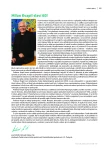Sepsis – how to recognize and what to focus on – back to basics in the light of the new definition
Authors:
Jan Horák 1,2; Martin Harazim 1; Thomas Karvunidis 1,2; Jaroslav Raděj 1,2; Ivan Novák 1; Martin Matějovič 1,2
Authors‘ workplace:
I. interní klinika LF UK a FN Plzeň
1; Biomedicínské centrum LF UK, Plzeň
2
Published in:
Vnitř Lék 2016; 62(7-8): 568-574
Category:
Reviews
Overview
Sepsis is the primary cause of death from infection. However, its early recognition remains a fundamental challenge in clinical practice. In February 2016, a newly revised sepsis definition has been published (SEPSIS-3). Sepsis has been redefined as life-threatening organ dysfunction caused by a dysregulated host response to infection. In this article, we introduce the updated definition of sepsis, discuss its pros and cons and suggest practical implications. The emphasis is put on basic and comprehensive clinical assessment.
Key words:
definition – early recognition of sepsis – infection – sepsis – septic shock
Sources
1. Fleischmann C, Scherag A, Adhikari NKJ et al. Assessment of global incidence and mortality of hospital-treated sepsis – Current estimates and limitations. Am J Respir Crit Care Med 2016; 193(3): 259–272.
2. Uvizl R, Adamus M, Cerny V et al. Patient survival, predictive factors and disease course of severe sepsis in Czech intensive care units: A multicentre, retrospective, observational study. Biomed Pap Med Fac Univ Palacky Olomouc Czech Repub 2016; 160(2): 287–297.
3. Liu V, Escobar GJ, Greene JD et al. Hospital deaths in patients with sepsis from 2 independent cohorts. JAMA 2014; 312(1): 90–92.
4. Kreymann G, Wolf M. History and definition of sepsis – do we need new terminology? Anasthesiol Intensivmed Notfallmed Schmerzther 1996; 31(1): 9–14.
5. Balk RA, Bone RC. The septic syndrome. Definition and clinical implications. Crit Care Clin 1989; 5(1): 1–8.
6. Bone RC, Balk RA, Cerra FB et al. Definitions for sepsis and organ failure and guidelines for the use of innovative therapies in sepsis. The ACCP/SCCM Consensus Conference Committee. American College of Chest Physicians/Society of Critical Care Medicine. Chest 1992; 101(6): 1644–1655.
7. Kaukonen KM, Bailey M, Pilcher D et al. Systemic inflammatory response syndrome criteria in defining severe sepsis. N Engl J Med 2015; 372(17): 1629–1638.
8. Singer M, Deutschman CS, Seymour C et al. The third international consensus definitions for sepsis and septic shock (sepsis-3). JAMA 2016; 315(8): 801–810.
9. Vincent JL, de Mendonca A, Cantraine F et al. Use of the SOFA score to assess the incidence of organ dysfunction/failure in intensive care units: results of a multicenter, prospective study. Working group on “sepsis-related problems” of the European Society of Intensive Care Medicine. Crit Care Med 1998; 26(11): 1793–1800.
10. Chvojka J, Matějovič M. Mezinárodní doporučení pro léčbu těžké sepse a septického šoku 2012 – komentovaný výběr. Vnitř Lék 2014; 60(1): 59–67.
11. Rhee C, Kadri SS, Danner RL et al. Diagnosing sepsis is subjective and highly variable: a survey of intensivists using case vignettes. Crit Care 2016; 20 : 89. Dostupné z DOI: <http://dx.doi.org/10.1186/s13054–016–1266–9>.
12. Goto T, Yoshida K, Tsugawa Y et al. Infectious Disease-Related Emergency Department Visits of Elderly Adults in the United States, 2011–2012. J Am Geriatr Soc 2016; 64(1): 31–36.
13. Whittaker SA, Fuchs BD, Gaieski DF et al. Epidemiology and outcomes in patients with severe sepsis admitted to the hospital wards. J Crit Care 2015; 30(1): 78–84.
14. Glickman SW, Cairns CB, Otero RM et al. Disease progression in hemodynamically stable patients presenting to the emergency department with sepsis. Acad Emerg Med 2010; 17(4): 383–390.
15. Ait-Oufella H, Joffre J, Boelle PY et al. Knee area tissue oxygen saturation is predictive of 14-day mortality in septic shock. Intensive Care Med 2012; 38(6): 976–983.
16. Ait-Oufella H, Bige N, Boelle PY et al. Capillary refill time exploration during septic shock. Intensive Care Med 2014; 40(7): 958–964.
17. Lima A, Jansen TC, van Bommel J et al. The prognostic value of the subjective assessment of peripheral perfusion in critically ill patients. Crit Care Medicine 2009; 37(3): 934–938.
18. Hernandez G, Regueira T, Bruhn A et al. Relationship of systemic, hepatosplanchnic, and microcirculatory perfusion parameters with 6-hour lactate clearance in hyperdynamic septic shock patients: an acute, clinical-physiological, pilot study. Ann Intensive Care 2012; 2(1): 44.
19. Rivers E, Nguyen B, Havstad S et al. Early goal-directed therapy in the treatment of severe sepsis and septic shock. N Engl J Med 2001; 345(19): 1368–1377.
20. Casserly B, Phillips GS, Schorr C et al. Lactate measurements in sepsis-induced tissue hypoperfusion: results from the Surviving Sepsis Campaign database. Crit Care Med 2015; 43(3): 567–573.
Labels
Diabetology Endocrinology Internal medicineArticle was published in
Internal Medicine

2016 Issue 7-8
Most read in this issue
- Treatment of liver cirrhosis – actually possibility of ambulant internist
- Sepsis – how to recognize and what to focus on – back to basics in the light of the new definition
- The skin – a mirror of internal diseases
- Prevention and therapy of sarcopenia in the ageing
